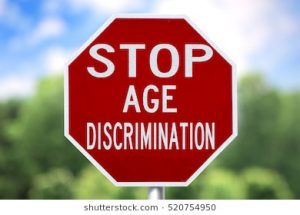 Federal employment law, in the Age Discrimination in Employment Act (the “ADEA”),prohibits employers from firing, refusing to hire, or discriminating in compensation, terms, conditions, or privileges of employment because of a person’s age. Case law has evolved over time regarding the extent to which age needs to influence employer decisions for the employer to violate the ADEA. A 2009 Supreme Court decision made a distinction between the ADEA’s prohibition against age discrimination and federal law prohibiting so-called status-based discrimination based on race, color, religion, sex, or national origin (Title VII of the Civil Rights Act of 1964). Title VII finds an employer culpable for employment practices for which race, color, religion, sex, or national origin is “a motivating factor,” even if other factors also motivated the practice.
Federal employment law, in the Age Discrimination in Employment Act (the “ADEA”),prohibits employers from firing, refusing to hire, or discriminating in compensation, terms, conditions, or privileges of employment because of a person’s age. Case law has evolved over time regarding the extent to which age needs to influence employer decisions for the employer to violate the ADEA. A 2009 Supreme Court decision made a distinction between the ADEA’s prohibition against age discrimination and federal law prohibiting so-called status-based discrimination based on race, color, religion, sex, or national origin (Title VII of the Civil Rights Act of 1964). Title VII finds an employer culpable for employment practices for which race, color, religion, sex, or national origin is “a motivating factor,” even if other factors also motivated the practice.
When an employee claiming age discrimination tried to use the “motivating factor” standard for the court’s decision, the Supreme Court disagreed that the standard was appropriate for age discrimination, instead turning to the language in the age discrimination law specifically, which states, “It shall be unlawful for an employer . . . to fail or refuse to hire or to discharge any individual or otherwise discriminate against any individual with respect to his compensation, terms, conditions, or privileges of employment, because of such individual’s age.” The Supreme Court found that the “because of” language brought the issue back to a term familiar in the legal realm, “but-for” causation — the idea that “but for” discrimination against the person’s age, the employer’s action would not have occurred. As applied in that way, the standard requires an employee to show that employer’s action (such as hiring and firing decisions) would not have occurred in the absence of age discrimination. That standard is harder to prove than proving that age discrimination was one of possibly other motivating factors.
Although the case itself and case law that followed emphasized that the decision reflected a distinction between the age discrimination law and discrimination for other reasons (such as race and religion), the reasoning behind the case has begun to seep into case law about other forms of discrimination. A 2013 case held that similar to the 2009 decision on age discrimination, a civil rights claim of unlawful employer retaliation for status-based discrimination requires proof that the desire to retaliate was the but-for cause of the challenged employment action (Univ. of Tex. Southwestern Med. Ctr. v. Nassar, 133 S.Ct. 978 (2013)).
Continue reading
 Against Discrimination has been amended many times since then to expand the protections against discrimination in employment, and decisions by New Jersey courts have interpreted the Law to provide much broader protections than those provided by similar Federal statutes such as the Federal Age Discrimination in Employment Act (known as the “ADEA”). However, the Law Against Discrimination is not without its flaws. The New Jersey Legislature acted in 2021 to fix one of these flaws by strengthening the protections against age discrimination.
Against Discrimination has been amended many times since then to expand the protections against discrimination in employment, and decisions by New Jersey courts have interpreted the Law to provide much broader protections than those provided by similar Federal statutes such as the Federal Age Discrimination in Employment Act (known as the “ADEA”). However, the Law Against Discrimination is not without its flaws. The New Jersey Legislature acted in 2021 to fix one of these flaws by strengthening the protections against age discrimination. New Jersey Lawyers Blog
New Jersey Lawyers Blog


 the Third Circuit hears federal appeals from the Federal District Courts in New Jersey, Pennsylvania, Delaware and the United States Virgin Islands, the case,
the Third Circuit hears federal appeals from the Federal District Courts in New Jersey, Pennsylvania, Delaware and the United States Virgin Islands, the case,  Jersey
Jersey  Amazingly, despite the law being clear for many years that age discrimination in employment is illegal, and despite the fact that both research and experience have shown the value of mature workers, age discrimination against older employees continues to be widespread in New Jersey and the country at large. Both the Federal Age Discrimination in Employment Act and New Jersey’s Law Against Discrimination provide strict prohibitions against employers and supervisors discriminating against older employees.
Amazingly, despite the law being clear for many years that age discrimination in employment is illegal, and despite the fact that both research and experience have shown the value of mature workers, age discrimination against older employees continues to be widespread in New Jersey and the country at large. Both the Federal Age Discrimination in Employment Act and New Jersey’s Law Against Discrimination provide strict prohibitions against employers and supervisors discriminating against older employees.